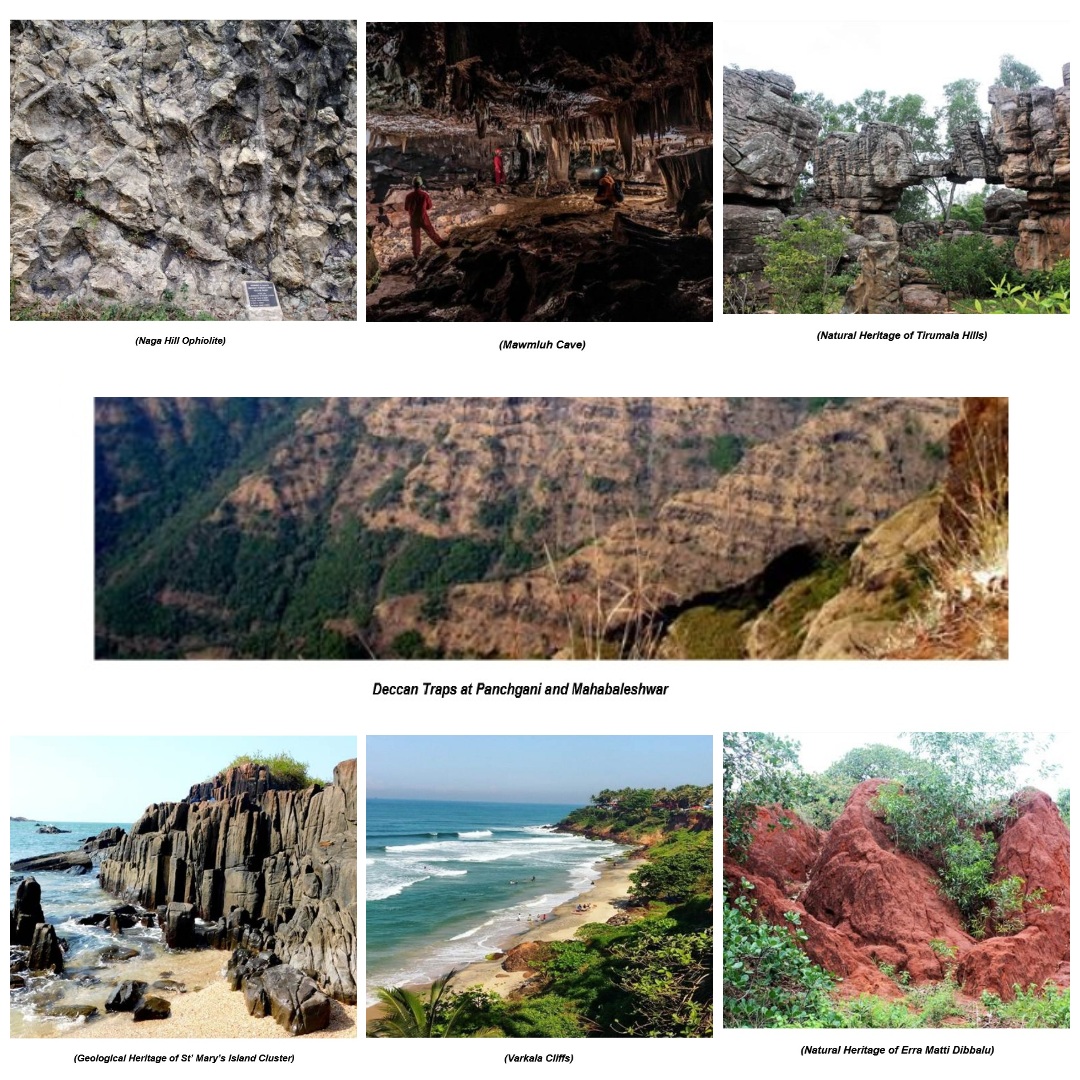Why in the News?
Seven natural heritage sites from India were added to UNESCO’s Tentative List of World Heritage Sites, raising India’s tally from 62 to 69 places.

About the 7 newly added UNESCO Tentative List Sites:
|
Site |
Detailed Facts |
| Deccan Traps (Panchgani & Mahabaleshwar, Maharashtra) | • One of the world’s largest volcanic provinces (~66 mya) • Basalt lava flows covering ~500,000 sq. km • Step-like “trap” topography, fossil beds, red bole layers • Linked to end-Cretaceous mass extinction • Part of Western Ghats; within Koyna Wildlife Sanctuary |
| St. Mary’s Island Cluster (Udupi, Karnataka) | • Four islands in Arabian Sea near Udupi • Famous for hexagonal/polygonal rhyolitic lava columns (~85–88 mya) • Formed during breakup of India–Madagascar • Declared National Geo-heritage Monument (2016) • Rare acidic lava formations, unique in India |
| Meghalayan Age Caves (East Khasi Hills, Meghalaya) | • Mawmluh Cave is type locality for Meghalayan Age (~4,200 years ago) • Records global drought event in late Holocene • Meghalaya has longest sandstone cave (Krem Puri – 24.5 km) • Karst systems preserve stalagmites, paleoclimate archives • Culturally significant to Khasi tribes; threatened by mining |
| Naga Hill Ophiolite (Nagaland) | • 200 km belt of uplifted oceanic crust & mantle rocks • Composed of gabbro, peridotite, basalt • Formed at supra-subduction / mid-ocean ridge zones • Later thrust onto Indian continental plate • Only major ophiolite exposure in India; National Geological Monument |
| Erra Matti Dibbalu (Red Sand Hills, Andhra Pradesh) | • Quaternary-age coastal red sand mounds (~12,000–18,500 years old) • Spread over 5 km near Visakhapatnam • Derived from ancient Khondalite rocks • Record climate shifts, sea-level oscillations, monsoon history • Mesolithic–Neolithic artefacts found; National Geo-heritage Monument |
| Tirumala Hills (Tirupati, Andhra Pradesh) | • Famous for Eparchaean Unconformity (1.5 billion-year gap) • Boundary between Archaean gneiss & Proterozoic quartzites • Hosts Silathoranam natural arch, rare erosional landform • Hills rise to ~900 m; part of Cuddapah Basin • Combines geological, tectonic, and spiritual significance |
| Varkala Cliff (Kerala) | • Coastal cliff escarpment up to 80 m high • Exposes Mio-Pliocene Warkalli Formation (1.3–25 mya) • Fossiliferous sedimentary rocks beside sea (rare in India) • Natural springs and aquifers emerge from cliff face • Declared National Geological Monument; major tourism hub (Papanasam Beach) |
Back2Basics: UNESCO’s Tentative List
- What is it: An inventory of cultural and natural sites that a member country plans to nominate for future World Heritage status.
- Requirement: A site must stay on this list for at least one year before nomination.
- Purpose: Allows UNESCO to assess Outstanding Universal Value (OUV) and plan conservation.
- Note: Not all sites on the Tentative List become World Heritage Sites.
- World Heritage Sites (WHS): Cultural, natural, or mixed sites recognised under the 1972 World Heritage Convention for their OUV.
- Categories of WHS:
- Cultural: Temples, monuments, forts, archaeological remains.
- Natural: National parks, caves, biodiversity zones.
- Mixed: Sacred landscapes with both cultural and natural value.
- 10 Criteria for Selection: A site must satisfy at least one of these:
- Cultural (i–vi): Masterpiece of human genius; interchange of values; unique cultural testimony; outstanding architecture/landscape; example of settlement/land use; linked to events, traditions, or ideas of universal significance.
- Natural (vii–x): Exceptional natural beauty; example of Earth’s history; ecological or biological processes; key habitats for in-situ biodiversity conservation and threatened species.
- India: It is currently a member of the UNESCO World Heritage Committee (2021–2025 term); Has 42 World Heritage Sites (34 cultural, 7 natural, 1 mixed).
| [UPSC 2024] Consider the following properties included in the World Heritage List released by UNESCO:
1. Shantiniketan 2. Rani-ki-Vav 3. Sacred Ensembles of the Hoysalas 4. Mahabodhi Temple Complex at Bodhgaya How many of the above properties were included in 2023? Options: (a) Only one (b) Only two* (c) Only three (d) All four |
Get an IAS/IPS ranker as your 1: 1 personal mentor for UPSC 2024

